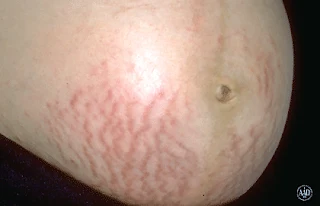Stretch Marks
Introduction
A stretch mark (stria) is a type of scar that develops when our skin stretches or shrinks quickly. The abrupt changes cause the collagen and elastin, which support our skin, to rupture. As the skin heals, stretch marks may appear.
- Early stretch marks are usually red or purple due to inflammatory reaction in the skin.
- Over time, stretch marks lose their colour and become white or silvery in appearance (replaced by scar tissue).
Causes
If you develop stretch marks, you are most likely to do so during these times.
- Growth spurts that happen in puberty
- Pregnancy
- Rapid weight loss or gain
- Weight training when you have rapid muscle growth
Other potential causes include:
- Prolonged use of oral or topical corticosteroid and from anabolic steroids
- People with Cushing syndrome or Marfan syndrome
Treatment Available
Stretch marks are non-life-threatening and asymptomatic.
- They naturally fade and usually become less conspicuous over time, so in many cases, treatment may not be necessary.
In other cases, if stretch marks are a cause of cosmetic concern, then the following treatments, or others, can be tried, but have not been proven to be effective:
- Moisturisers
- Topical retinoid therapy (e.g. tretinoin) or hyaluronic acid
- Chemical peels
- Pulsed dye laser therapy
- Skin microneedling
- Injection of platelet-rich plasma
NOTE: Topical retinoids should be avoided during pregnancy.
Prevention
Although many women use a wide variety of creams, lotions, and ointments in attempts to reduce risk for striae development, strong evidence to confirm efficacy of any of these interventions is lacking.
- A 2012 systematic review of randomized trials that included trials assessing olive oil; cocoa butter; a product containing hyaluronic acid, vitamins A and E, allantoin, and calcium pantothenate; a product containing C. asiatica extract, alpha-tocopherol, and collagen-elastin hydrolysates; and a product containing vitamin E, essential free fatty acids, panthenol, hyaluronic acid, elastin, and menthol found no high-quality evidence to support the use of these topical preparations to prevent striae distensae during pregnancy.
- In addition, a subsequent randomized trial (n = 360) comparing use of olive oil or a cream containing lanolin, stearin, triethanolamine, almond oil, and other ingredients with no treatment found that neither intervention was effective for prevention.
External Links
- AAD - Stretch Marks: Why They Appear and How to Get Rid of Them
- Better Health Channel - Stretch Marks
- Mayo Clinic - Stretch Marks
- UpToDate - Striae distensae (stretch marks)
- Topical preparations for preventing stretch marks in pregnancy, 2012
- The effect of olive oil and the Saj® cream in prevention of striae gravidarum: A randomized controlled clinical trial, 2014
- Stretch marks during pregnancy: a review of topical prevention, 2015
- Therapeutic targets in the management of striae distensae: A systematic review, 2017

Comments
Post a Comment